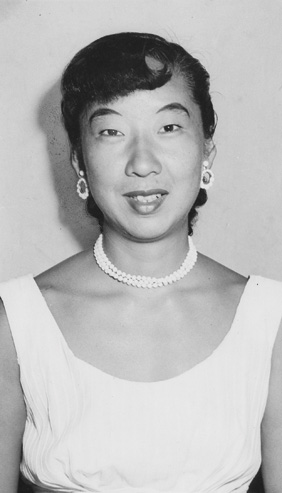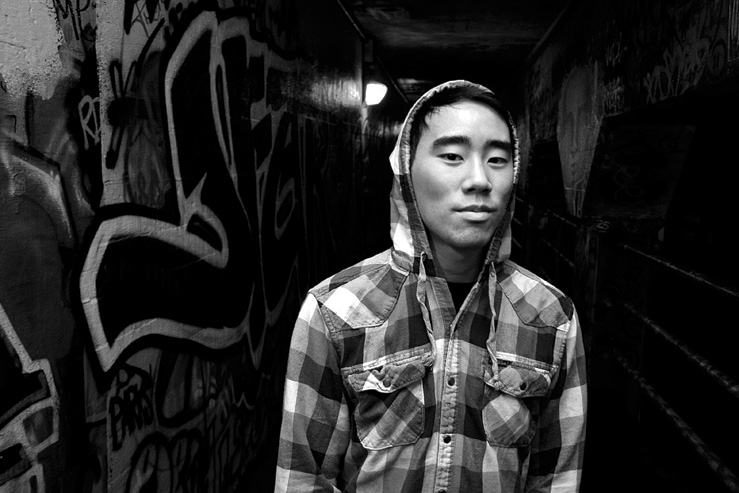By Kathleen Richards
Sarah Park could have disappeared into the shadows of history. But 52 years after her untimely death — almost to the day — she’s finally being honored for her work.
The pioneering Korean American journalist for the Honolulu Star-Bulletin was just 29 years old when, while covering a tsunami warning, the small plane she was aboard crashed into the Pacific Ocean. Park and the pilot were killed, but a photographer survived. Despite her young age, Park had already made a name for herself, not just with her vibrant personality, but also for her imaginative features reporting in the island territory and as a courageous war correspondent, reporting from the frontlines during the Korean War.
And yet, few people today know of her work. That will change on March 30 when Park is honored at the Journalists Memorial in Washington, D.C., her name etched into a two-story glass wall alongside 1,842 other reporters, photographers and broadcasters killed in the line of duty.
[ad#336]
“She represents the message we’re trying to send, that it’s not easy to be journalist, it’s not easy to get the truth,” said Patty Rhule, project editor at the Newseum, which houses the memorial wall. “She kind of captured that spirit of what we’re trying to show with the Journalists Memorial.”
Every year, the journalism museum honors news gatherers who are killed while working the year prior. But it also looks for historical figures that may have been overlooked in the past.
Rhule says that an executive for the Newseum came across Park’s name in a newsletter last summer put out by United Press International, of which Park was a member. The executive then alerted the memorial’s researchers, who looked into her story and nominated her for the honor. So far, she’s the only reporter killed in 1957 featured by the Journalists Memorial. Veteran Korean American journalist K.W. Lee also believes she may be the only Korean American on the list.
In addition to having her name etched into the monument, Rhule says there will be a small display with Park’s photo and a short biography. “She was quite a firebrand,” said Rhule. “She had done some amazing things in her very short career.”
***
[ad#336]
Even to a casual observer, it was clear that Sarah Park was going to leave her mark on the world. Newspaper articles from the time of her death reported that she was born in Honolulu on June 22, 1927. Her mother was Shinbok Park, a devout woman who had immigrated to Hawaii from Korea, according to her granddaughter Esther Hong. Mrs. Park had two sons, Thomas and William, and two daughters, Soo-ae and Sarah, who was the youngest. According to Esther Hong, William’s daughter, the elder Park was a successful businesswoman who owned a carnation plantation. (Not much is known about her father, Choonha Park.)
Early on, young Sarah displayed a sense of courage and tenaciousness impressive even by today’s standards. According to the Honolulu Star-Bulletin, Park attended the Maret School in Washington, D.C., where she learned to fly a plane. She took her first solo flight at age 16. That same year, Park started lobbying to get a Civil Air Patrol Unit for Hawaii. According to one article, “To make an impression (and hide her age) she, in her own words, ‘put on a slinky black dress, lipstick and a floppy hat’ and went to New York City to see the top C.A.P. general and ask for a Hawaii unit.” The general told her Hawaii wasn’t eligible because it wasn’t a state. So, “As Brigadier General Earle Johnson told it later: ‘She practically camped on General Spaatz’s desk until he told someone to see about changing the rules to admit Hawaii.’”
Park studied at American University in Washington, D.C., and at the University of Hawaii. Not long after, she began living and writing in Asia for the International News Service and the Reuters agency of Great Britain. By age 23, she was producing “keen analyses and incisive writings” about India, Indonesia, Korea and China, according to the Honolulu Star-Bulletin.
That caught the eye of editors at the Star-Bulletin, who hired her in 1950. By the end of January 1951, her reporting on communism in Indochina resulted in her being blacklisted by the Soviet magazine the Literary Gazette. When the Korean War erupted, Park was sent to cover the conflict.
Hong, who was living in Korea at the time, says her aunt’s visits made quite an impression on her. “Compared to my mother, she was much taller,” the niece recalled, sitting at her dining room table in Piedmont, Calif., sipping tea. “She looked so different because she was from Hawaii. She was suntanned, she looked like a foreigner. She didn’t speak any Korean, only ‘omeoni’ (mother).”
But Park was always on the go, “always working,” said Hong. Her reporting went beyond just relaying the facts. In her coverage of the conflict on the peninsula, she lent intimacy not only to the predicament of her mother country, but also to the plight of the U.S. soldiers.
On December 21, 1952, she wrote: “Korea is a bleak, tired looking country. It looks like a weary old man, dried up and emotionless, listless and worn. The country side is padded with rolling hills, sharp peaks and mountains the color of pinkish taffy … and dotted with pines and scrub oaks. … On Christmas Eve and Christmas Day, Hawaii soldiers will join United Nations forces in … guarding Korea’s taffy like hills. These are the men who sit by their guns, go on patrol on nights when the mercury slides below zero. To them, Christmas is just another day. It’s a day of extra vigil, just in case the enemy decides to try and take advantage of American sentimentality about the birth of Christ.”
Park’s reports captivated the minds of readers back home. After she wrote about the absence of lighting in bunkers and dugouts, a campaign called “Candles for Korea” was launched, resulting in Hawaiian residents donating 150,000 candles to the frontlines.
In January 1953, Park was awarded the Bayonet Badge and became an honorary member of the U.S. Army’s Seventh Division for her reporting and contributions to the unit’s morale. Wrote Lt. Colonel Arthur B. Chun in a letter to the Star-Bulletin: “Undaunted and without flinching, she stood side-by-side with men of the 3rd Battalion, 23rd Infantry Regiment, 2nd Division, all under intense fire from the enemy on the Korean frontier. She walked their trails, their trenches, their rugged hills and witnessed their agonizing, perilous moments. She was more than a war correspondent or an observer: she was the understanding ‘buddy’ from home who appreciated everything anyone did.”
[ad#336]
After the war, back in Hawaii, Park continued her fearless reporting. She dived for coins, posed as a blind woman on the street to see how people would react, and got a job as a taxi dancer to understand the problems facing dance-hall girls.
When the famous German surrealist painter Max Ernst gave a lecture at the University of Hawaii, Park covered it in her own unique way. “She did a real avant-garde news story,” recalled her Star-Bulletin colleague Lyle Nelson, who is now retired. “I read that recently and was quite humored by her approach to it because she knew the culture, she knew art, she knew music. She was pretty broadly informed on a lot of things.”
And it wasn’t her Korean heritage or gender that made her unique. Nelson said the newspaper’s staff at the time was ethnically diverse, with plenty of female reporters. It was her personality, which Nelson described as “lively,” that made her a stand-out. “Here was a woman who could really jump around and laugh,” he said. “She was not a real serious type. Not quite the laugh of the party, but she could be very animated in the office. And she put a lot of enthusiasm into her efforts. I think we all looked at her that way at the time.” He also called her “quick and intelligent and quite fun-loving.”
While Park clearly loved her work, her passions also extended beyond the newsroom. “She loved clothes, she loved fashion,” said her niece, Puamana Kim Park, who lives in Honolulu. “She was also very much a rascal, and [for] the Koreans back then, it was kind of unheard of. She was not reserved … quite the opposite — very friendly and outgoing.” According to the Star-Bulletin, she was a big fan of the comic strip character Charlie Brown.
Her sense of adventure was even evident in her home. “She had a lot of birds, and she had a monkey,” remembered her nephew, Robert Park, of Phoenix, Ariz. Yet, “she wasn’t home much, she was always on the go somewhere,” he said.
***
[ad#336]
On the morning of Saturday, March 9, 1957, news hit the Star-Bulletin of a seismic wave warning. Park was assigned to cover the story.
She decided it would be best to see the waves from the air, and enlisted the help of a friend, Paul Beam, a Honolulu advertising executive who owned a small yellow Piper Cub plane. Along with photographer Jack Matsumoto, the trio took to the sky.
According to Matsumoto’s recollection shortly thereafter, the atmosphere was lighthearted. Park joked with Beam. She was laughing and excited.
“Oh, look at that water,” she exclaimed, as the plane flew over Kaneohe Bay. The plane banked so Matsumoto could get a photo of the waves and the people watching ashore.
But at Laie Point, the plane banked and fell away. The plane plunged into the sea. The right side of the aircraft — where Sarah was sitting — was torn open by the impact. She was killed instantly.
Matsumoto climbed out onto the wing and was rescued by a couple of marines onshore. Beam suffered severe injuries to which he succumbed the next day.
As news of Park’s death spread, letters of condolences poured in from across the globe. Numerous articles paid tribute to her. At her eulogy, Riley H. Allen, editor of the Star-Bulletin, said, “No death during my 46 years of residence in Hawaii has brought such varied expressions of shock, of loss, of sympathy, of admiration from so many parts of the world as that of Sarah Park.”
The tragic ending of Sarah Park wasn’t just a loss for journalism. She was engaged to be married at the time, said her niece, Puamana. And she had other plans too, according to newspaper reports, like telling a prisoner at Oahu Prison of news that might shorten his term; continuing her campaign to open Diamond Head for public use; and traveling to Europe and storming Paris as a “Tibetan princess.”
Unfortunately, Sarah didn’t get the chance to do any of those things. But 50 years after her death, she’s still making an impact.
“She’s an inspiring figure for future generations,” said K.W. Lee, who himself was inducted into the Newseum’s News History Gallery in 1997. “This is nothing but the latest example of how far we must explore the untold stories of not just the Korean, but the Asian American journey.”
Sarah Park is buried in Diamond Head Memorial Park in Oahu, next to her mother.






